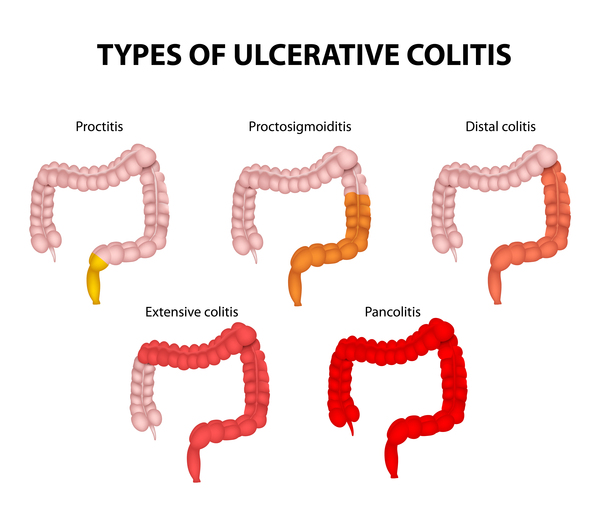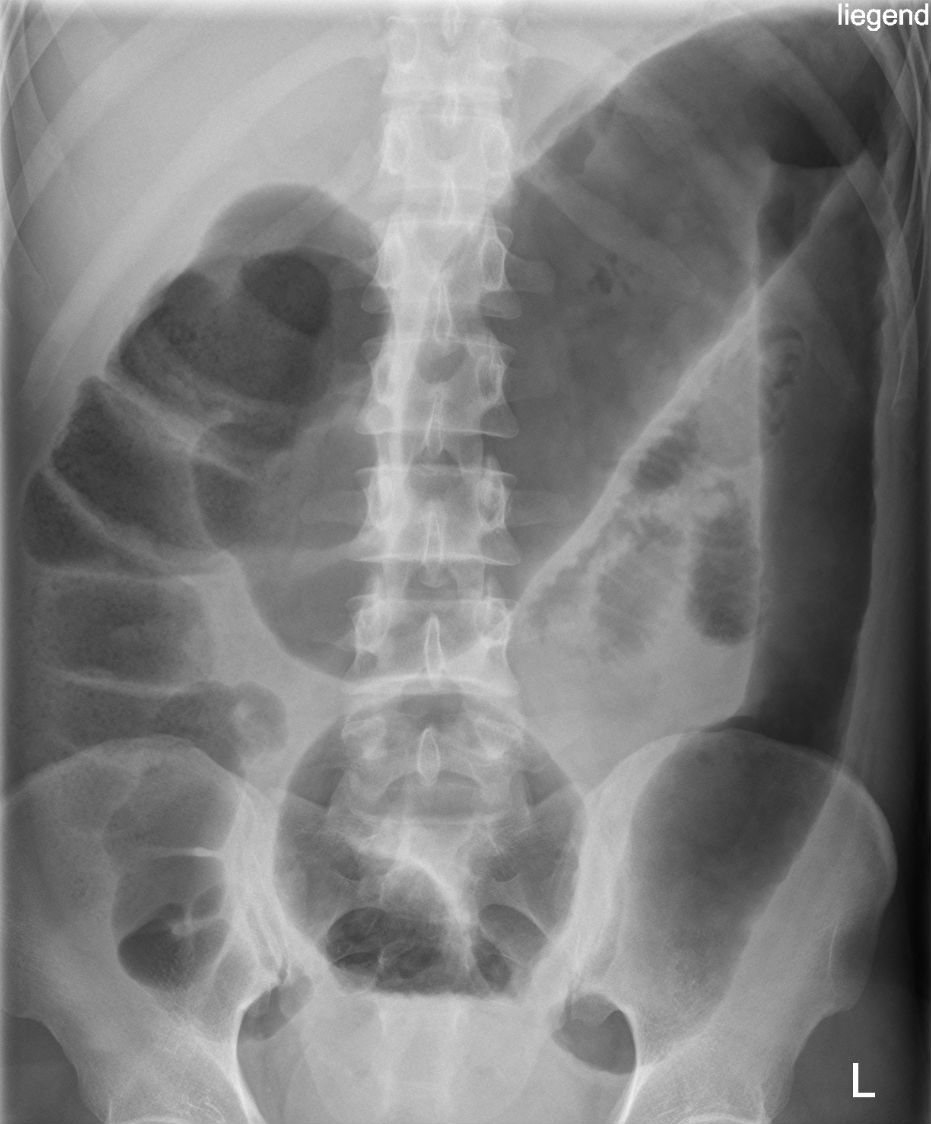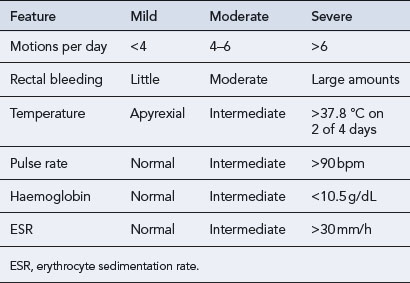Related Subjects:
|Acute Severe Colitis
|Ulcerative Colitis
|Microscopic colitis
|Irritable bowel syndrome
|Lower Gastrointestinal (Rectal) Bleeding
This is a relapsing-remitting colonic inflammatory disease with a long term colonic cancer risk. It may present with or cause an episode of acute severe colitis
About
- Relapsing remitting colonic inflammatory disease
- Inflammatory bowel disease commoner than Crohn's disease
- Increasing incidence 10-20/100,000 and Prevalence 50-100/100,000
- Commoner in Caucasians/Jewish - US/US/European populations
Aetiology
- Response to an environmental trigger
- Smoking appears to be protective
- Appendicectomy appears protective
- Increased pANCA
- Increased Primary sclerosing cholangitis and other systemic complications
Extent of disease and description. Tends to start distally


Clinical
- Patients present with diarrhoea often mucus and bloody
- Patients may complain of diarrhoea often 10-20/day and urgency
- Flare up can be provoked by infection, stress, NSAIDs, antibiotics
- Crampy abdominal pain, weight loss, fever
- Inflamed colon always gets tries to get rid of faeces
Additional Findings
- Erythema nodosum - painful red lesions usually over the lower legs
- Eye disease - conjunctivitis, iritis, episcleritis
- Joint pain - large joints, migratory, asymmetrical
- Ankylosing spondylitis - commoner with Crohn's disease
- Sacroilitis - low back pain, Mouth ulcers
- Pyoderma gangrenosum - starts as a pustule that expands to a large ulcer with violaceous margins. Biopsy and surgery to the lesion can make it worse.
- Clubbing, Colon cancer, Osteomalacia, Amyloidosis
- Liver disease - Hepatic steatosis, cholangiocarcinoma, cholelithiasis
- Primary sclerosing cholangitis - associated with positive pANCA
- Venous thromboembolism - commoner
Pathology
- Starts distally and confined to Colon and rectum (proctitis)
- Pan colitis develops in 30% over 10 years
- Lesions are usually continuous
- Goblet cell depletion, Crypt abscesses, shortening and pseudopolyps
- Chronic inflammation in lamina propria (not transmural)
- Mucosal islands between severely ulcerated erythematous haemorrhagic mucosa
- Long term loss of haustra and featureless atrophic bowel.
- Malignancy risk long term
Assessing for severe disease

Severe colitis
- Stool frequency > 6/day
- Temp > 38 C
- Pulse > 90 bpm
- ESR > 30 mm/hr
- Hb < 10.5 g/dl
Severity (modified Truelove and Witt's criteria)
- Mild: bloody stool <4/day and at least one of temp <37.5 C, HR <90/min, ESR <20 mm/h, CRP <5 mg/dL, Hb >115 g/L.
- Moderate: bloody stool 4-6/day and at least one of temp < 37.8 C, HR = 90/min, ESR =30 mm/h, CRP <30 mg/dL, Hb >105 g/L.
- Severe: bloody stool >6/day and at least one of temp >37.8 C, HR >90/min, ESR >30 mm/h, CRP >30 mg/dL, Hb <105 g/L.
- Fulminant: 10+ stools/d, continuous bleeding, toxicity, abdomen tender or distension, transfusion requirement, colonic dilation on AXR.
Investigations
- FBC - anaemia? Hb , ? Ferritin as acute phase reactant
- U&E - dehydration? urea and creatinine
- CRP/ESR -? with inflammatory response
- LFTs -? albumin. ? ALP/AST with associated liver disease
- Increased faecal calprotectin
- Positive pANCA in 70% (the actually pANCA antigen is different to the pANCA seen with vasculitis)
- Positive anti-Saccharomyces cerevisiae (ASCAs)
- AXR - megacolon with colonic diameter > 6 cm, perforation, no faeces, mucosal oedema, thumb printing
- Sigmoidoscopy shows erythematous inflamed even haemorrhagic mucosa and allows biopsies
- Colonscopy can also be done to show the extent of the disease and to exclude malignancy in long-standing colitis. Often avoided in the acute episode.
- Barium enema - may show loss of haustral pattern and featureless colon. Avoided during acute flare-up.
- Biopsies - goblet cell depletion, inflammatory, mucosal ulcers, crypt abscesses
Management
- Mild disease such as less than 4 stools per day can combine a short course of oral e.g. Prednisolone 20 mg reducing over 2 weeks along with starting mesalazine [US Mesalamine] 500 mg qds or Sulfasalazine [US Azulfidine or EU Salazopyrin] 1g bd po. For distal disease rectal Mesalazine is useful for rectal disease. Sulfasalazine and its similar agents such as Mesalazine and Olsalazine comprise molecules of 5-ASA an anti-inflammatory attached to another molecule by an azo bond. The azo bond is broken down by bacteria producing azo reductases in the colon reducing the ASA moiety. With salazoyrin the ASA is attached to the antibiotic sulfapyridine. High doses of sulfasalazine 6-8 g/d can cause headaches, anorexia, rash, fever, azoospermia and folate malabsorption.
- Moderate disease Prednisone 40-60 mg od reducing dose is used for acute attacks. Steroid enemas and suppositories for proctosigmoiditis. Prednisolone 40 mg od reducing perhaps over a month combined with Mesalazine (Pentasa) may be used.
- Severe disease will require admission for IV fluids, basic bloods and investigations and IV Hydrocortisone. See below for further acute management.
- Toxic Megacolon - life-threatening colonic inflammation can occur in UC and CD often with the initial attack of colitis. There is abdominal pain and the patient is toxic. AXR shows dilated bowel, thumb printing and mucosal oedema and if bowel diameter > 6 cms there is a high risk of perforation. Joint care from both gastroenterologists and surgeons. Transfuse > 10 g/dl. IV Methylprednisolone. Nutritional support, IV Antibiotics, VTE prophylaxis. Twice daily abdominal circumference. Consider IV Ciclosporin or Infliximab if no response to high dose steroids after 3-5 days reduces the need for surgery. Laparotomy and urgent colectomy if fail to settle.
- Elective Surgery - may still be needed with ongoing disease. Usually, a pan proctocolectomy removing colon and rectum with a pouch procedure. The operation is curative. However the main problem is defaecation 6-8 times a day as pouch capacity is low. Some may develop a pouchitis. It does however remove the cancer risk.
Other agents
- Azathioprine/ Mercaptopurine : When fails to settle with 5-ASA and require steroids. Steroid sparing agents. Side effects are Bone marrow suppression and pancreatitis. Need to closely monitor FBC.
- Infliximab a monoclonal antibody to TNF alpha or other biological treatments used for severe disease.
- Ciclosporin [US Cyclosporin] - Consider in those with severe disease who fail to settle with IV steroids
Other important factors
- Nutrition - Dietician involvement to maximise nutrition
- Nurse specialist ongoing support can be beneficial and allow earlier access to expert care for acute flare ups
Step up Medical therapy for Ulcerative colitis
| 1 | Rectal/Oral 5-ASA - Sulfasalazine, Mesalazine, Olsalazine |
| 2 | Rectal steroids |
| 3 | Oral Steroids e.g. Prednisolone 40-60 mg reducing dose |
| 4 | IV steroids - Hydrocortisone/Methylprednisolone |
| 5 | 6 Mercaptopurine or Azathioprine |
| 6 | IV Ciclosporin or Infliximab |
References